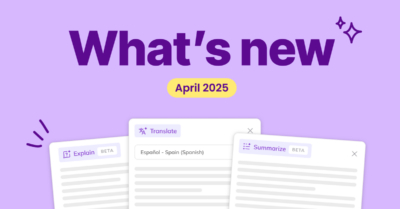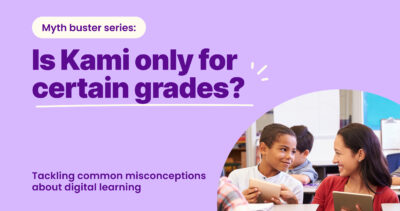Shirin Bradfield
By Patricia Ferris, Instructional Technology Coach, Learning Technology Center
Edited by Sam Fishel, Digital Content Specialist, Learning Technology Center
While scrolling through my news feed recently, I came across a caption that I’ve been thinking about ever since – “Don’t DIS my ABILITIES!” Those four words have really stuck with me because they perfectly capture the spirit of Learning Disability Awareness Month, which has always meant a lot to me personally as both an educator and a parent. Both have taught me valuable life lessons about advocating for others, and ensuring all students have opportunities to learn with confidence.
Advocating for my child
My earliest experiences in the student advocacy arena were at home with my son. During his first few years in school, he was an ideal student who teachers often praised for his positive behavior, his friendly demeanor, and his willingness to help others.
But as he started to progress through grade school, I noticed gaps forming in his learning that grew year-to-year. I remember countless nights spent reteaching and reviewing concepts, which often ended in frustration for both of us. As a mother and educator, I knew my son was not learning at the same developmental level as his peers. More importantly, I knew he couldn’t continue to thrive in school if we maintained the status quo.
Fortunately, our family started getting answers around the same time. At age seven, my son was diagnosed with attention deficit disorder (ADD), atypical learning disability, low executive function, and later, autism. To that end, we discovered that his positive behavior had been masking his learning disabilities up to that point. All of these discoveries help us better understand how we could support our son’s learning and make the most of his existing abilities.
The next step was to get my son’s school onboard. After three years of asking, “Are you sure he is ready to move on?” and “Can you please assess my son for a learning disability?”, they initiated the IEP process and started providing appropriate support. By the beginning of second grade, my son received the support and strategies he needed to make reliable progress in his educational journey.
Eventually, my son (now 26) began to grow academically and gain independence in advocating for himself. During his final evaluation before moving to the high school district, the IEP team congratulated him on increasing his IQ into an average range. In turn, they determined that he no longer required special education services moving forward.
I was ecstatic about my son’s success, as any parent would be. But I also knew that it would be challenging for him to continue on this path of academic and personal success without the support of an IEP and the SpEd team.
So, I stepped in again and advocated for my son to continue receiving services throughout his high school career. The school’s SpEd team agreed, and with those supports still in place, my son successfully graduated high school. Most importantly, though, he gained confidence along the way and grew to understand the value of advocacy, especially for himself.
Advocating for Students
Now in my professional role as an instructional technology coach, I continue to work as an advocate for learners like my son. More specifically, I work with educators of students with a range of learning, cognitive, and physical disabilities and impairments to ensure they are able to productively integrate educational technology into their classrooms.
Last year, I began working with an Illinois-based special education cooperative for students with diverse and severe disabilities. Up to that point, I had never worked solely with educators of students with mobile, cognitive, vision, and hearing impairments.
Needless to say, all of those special educators are rock stars! Even from day one, working in their classrooms was an eye-opening experience. The daily physical and mental exhaustion they encounter and the creativity of differentiating instruction they call on each day is beyond comparison. Day in and day out, these teachers are dependable advocates for their students, always focusing on their students’ abilities as a starting point rather than emphasizing what they could not do.
One educator, in particular, truly exemplified this mentality in practice. In my conversations with her, she made clear that she did not see limitations in her students and wanted them to have the same opportunities and experiences as students in general education classrooms. When I suggested an introductory coding lesson for her, her reply was an unmistakable, emphatic, “YES!”.
On the day of the lesson, most of the students felt challenged at first, especially when it came to following the steps needed to successfully code. But because of their teacher’s example, they were eager to learn and persevered. Their teacher was amazed at how focused and determined they were, and to her surprise, some of the students completed the lesson independently and began helping their fellow classmates. One student even took over teaching the class while I was helping another student.
Both in the moment and looking back now, all I can think is “WOW! This is exactly what teaching is all about: student-led learning and focusing on what students can accomplish when given an opportunity to persevere.” Those students had that opportunity to grow because their teacher advocated for them, opening the door for them to acquire new skills and even teach themselves.
Just imagine how many “teachers” we can foster in classrooms like this when we don’t DIS their ABILITIES!
Strategies for Supporting Students with Learning Disabilities
While not every strategy works with every student in every learning environment, there are some tried and true teaching and learning strategies that can help many students with learning disabilities. Here are a few that helped my son flourish in a variety of academic settings:
- Extended time (elementary through college)
- Additional set of classroom materials at home
- Peer support in the classroom, such as checking a classmate’s planner to ensure all assignments were recorded and that all notes/communication are placed in the correct folder
- Graphic organizers for all content areas
- Modified assignments
- Copies of teacher’s notes and presentations (high school and college)
- Note taker (in college)
- Small group testing environment (to minimize distractions)
- Audio recording of text
- Whisper phones to hear themselves read and increase comprehension
- App-based accessibility tools
- Digital learning accessibility devices
- Structures and routines that cultivate independent learning
Read our other blog about Learning Disabilities Awareness Month and how Kami is designed with learning disabilities in mind.
You may also like

Unlocking understanding: Kami’s latest updates designed for every learner

The state of SPED and ELL technology in 2025

